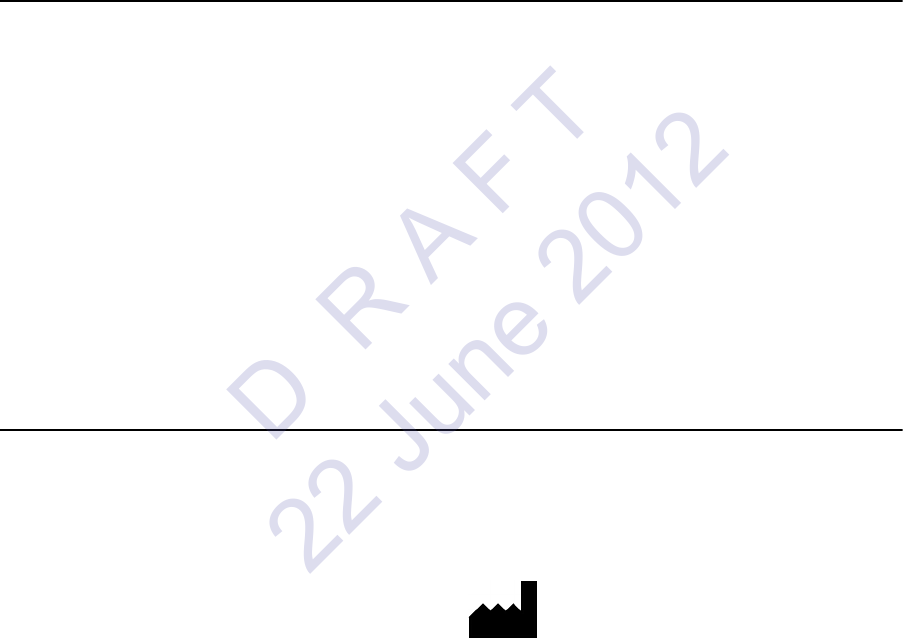User's Manual
Table Of Contents
- Telemetry Transmitter
- Table of Contents
- Conventions Used in This Manual 1-1
- Nurses 1-7
- Monitor Technicians 1-7
- Biomedical Engineers 1-7
- Physicians 1-7
- Patients 1-7
- Sources of Interference 1-8
- Potential Sources of Damage 1-8
- Optional Leadwire Grouper 2-3
- Leadwire Color Codes 2-4
- Telemetry Channel Label 2-5
- Adult Electrode Placement 3-3
- Lead Fault Indication 3-4
- Noise Detection 3-4
- False Alarms 3-5
- Traditional Pulse Oximetry 3-5
- Electrodes, Leadwires, Sensors, and Sensor Cables 3-7
- Electrodes, Leadwires, Sensors and Sensor Cables 3-8
- Spacelabs Healthcare Technology 3-13
- Additional Information for Telemetry Products 3-13
- Telemetry 3-13
- Heart Rate Averaging 3-13
- Spacelabs Healthcare SpO2 Sensors 3-18
- Additional Information 3-18
- Transmitter Batteries 4-1
- Host Monitors 4-2
- Telemetry Receiver Module 4-2
- Assigning a Telemetry Channel 4-3
- Top, Front and Bottom View (96281-C) 4-4
- Rear View (96281-C) 4-5
- Front View (96281-A) 4-6
- Battery Compartment (96281-A, 96281-B, 96281-C) 4-7
- ECG 4-12
- SpO2 4-14
- Cleaning/Disinfecting 5-1
- Recommended Cleaning Solutions 5-2
- Basic Cleaning and Low-level Disinfection 5-3
- Cleaning ECG Leadwires 5-3
- Cleaning Buttons 5-3
- Cleaning the Battery Cover 5-3
- Table 1—Electromagnetic Emmissions A-1
- Table 2—Electromagnetic Immunity A-2
- Table 2—Electromagnetic Immunity (continued) A-3
- Table 3—Separation Distances A-4
- Introduction
- About the Transmitters
- ECG and SpO2
- ECG Overview
- Patient Preparation and Electrode Application
- To Set Up ECG Monitoring
- ECG Problem Solving
- SpO2 Overview
- Warnings and Cautions for SpO2
- Setting Up SpO2 Monitoring
- Ensuring Accurate SpO2 Monitoring
- SpO2 and Pulse Rate Specifications
- Using the Sensorwatch Feature
- Enabling and Adjusting Alarms
- Data Averaging
- Display Details at the Host Monitor
- Printing SpO2 Waveforms
- SpO2 Messages at the Host Monitor
- Sensors
- SpO2 Alarm Delays
- SpO2 Troubleshooting Guide
- Basic Operations
- Getting Started
- Basic Components
- Selecting Options for Leads
- Basic User Actions
- Basic Modes of Operation
- View Mode
- Status Messages at the Host Monitor
- Telemetry Transmitter with ECG Only Troubleshooting Guide
- Telemetry Transmitter with Display Troubleshooting Guide
- Telemetry Transmitter with Display and SpO2 Troubleshooting Guide
- Cleaning, Disinfecting, and Sterilization
- Appendix A — Guidance and Manufacturer’s Declaration
- Appendix B — Symbols

TELEMETRY TRANSMITTER (96281) OPERATIONS MANUAL 1-2
I NTRODUCTION
• Warnings, cautions, and notes are listed in the priority of the information and formatted specifically
as shown below. Warnings are of the highest priority and notes are not as serious as the warnings
and cautions.
Warnings:
Warnings indicate potentially harmful conditions that may lead to injury or death.
Cautions:
Cautions indicate conditions that may lead to damage to or malfunction of the device.
Notes:
Notes alert the user to relevant facts and conditions.
Overview of the Telemetry Transmitter
(96281-A/96281-B/96281-C)
When worn by a patient, the 96281 telemetry transmitter acquires ECG data through electrodes
attached directly to the patient’s body. Additionally, the 96281-C telemetry transmitter can acquire
SpO
2
data through sensors attached to the patient’s body. It transmits acquired data to the
telemetry antenna infrastructure for processing by a telemetry receiver. This transmitted data may
then show on a central station or bedside monitor. Refer to About the Transmitters on page 2-1 for
more detailed information about each telemetry transmitter model. The 96281 telemetry transmitter
does not indicate any alarm conditions. Alarms are configured, generated, and activated within the
receiver-side components of the Ultraview System only.
Note:
SpO
2
functionality is only available on the 96281-C telemetry transmitter.
Manufacturer
The 96281 telemetry transmitter is manufactured by:
Spacelabs Medical, Inc.
5150 220th Avenue, S.E.
Issaquah, Washington 98027
U.S.A.
D R A F T
22 June 2012










